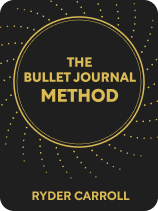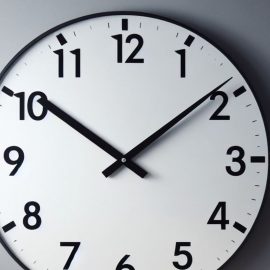

This article is an excerpt from the Shortform book guide to "The Bullet Journal Method" by Ryder Carroll. Shortform has the world's best summaries and analyses of books you should be reading.
Like this article? Sign up for a free trial here .
Do you want to start a bullet journal but don’t know where to begin? What types of pages should you create, and how often should you write?
In his book The Bullet Journal Method, Ryder Carroll tells you how to create, maintain, and review your bullet journal. He also provides suggestions on what bullet system to use and how to index.
Here are the basics of Ryder Carroll’s Bullet Journal Method.
Getting Started With the Bullet Journal Method
According to Carroll, the only tools Bullet Journaling requires are a notebook and a pen, and there are no limits to which ones you choose. He notes that the Bullet Journal Method is all about function over form. Although you’re free to design your journal in whatever way suits you, your choices shouldn’t interfere with the journal’s purpose, your ability to decipher your handwriting, or your capacity to maintain your journaling habits.
(Shortform note: While Carroll’s suggestion to prioritize function over form has its advantages, for some, aesthetics are functional. Specifically, certain people may find that the artistic possibilities of Bullet Journaling increase their motivation to journal and encourage creativity, even if they require more time and energy. Joshua Waitzkin echoes this idea in The Art of Learning, where he argues that failing to honor what most resonates with you about a particular activity may cause you to lose your passion for it. Therefore, if your favorite part of bullet journaling is designing artistic layouts, don’t feel you have to sacrifice that in favor of purely functional designs.)
With this in mind, the next step is to set up the main organizational components of your journal. Let’s discuss each of these in order, focusing on what they are and how to use them:
Index
Carroll explains that the Bullet Journal’s index is a hybrid between a table of contents and a traditional index. It’s a set of pages at the front of your journal that keeps a running list of all the instances of a particular topic, no matter where or how often it appears. As you fill your journal, you’ll populate the index by listing new topics’ titles and their corresponding page numbers (such as “Coding Project: 20–21, 42–44”).
(Shortform note: As Carroll explains, the index keeps track of all the sections you add to your journal by listing their titles and page numbers. However, this means it can’t help you find anything other than high-level sections of your journal—whereas a traditional index keeps track of all key terms and topics, Carroll’s index only includes titles. As a potential solution, add important or frequent topics or keywords to your index along with section titles. That way, you can keep track of everything you’re likely to return to without overwhelming your index with too many entries.)
Future Planner
For tasks and events more than a month away, Carroll recommends designating four pages in your journal as the “future log” (which we’ll call the “future planner”). The future planner is a waiting list for all future tasks and events you don’t want to lose sight of. It aids your planning because it shows you what will require your attention in the months to come and gives you enough foresight to let you change plans and goals as your needs and values shift. To utilize your future planner, organize all future tasks and events by month so that you can see an overview of not only each month but also the year as a whole.
(Shortform note: Carroll praises the future planner’s ability to give you perspective and then adjust your plans accordingly. However, there are additional benefits of planning ahead that he doesn’t discuss: Planning future tasks and events on paper can help you hold yourself accountable, keep you motivated, and save you time that you can then spend on the things that matter most. In addition, it can reduce stress by encouraging you to take an active role in your life, help you live in the present moment by forcing you to slow down while writing, and boost your mood by reminding you of all the good experiences you have to look forward to.)
Monthly Overview
Carroll describes the “monthly log” (which we’ll refer to as the “monthly overview”) as a two-page tool that summarizes your available time and upcoming responsibilities in the next month through a calendar and task list. He argues that the monthly overview’s overhead perspective helps keep you aware of both your available capacity and the way you’re allocating your time, preventing burnout and offering opportunities for reflection.
(Shortform note: Carroll’s focus here may be time capacity, but your energy capacity is also important in deciding how to plan out your life. Even if your calendar is empty and your task list is short, you still may not have the energy to allocate to new commitments. Therefore, while the monthly overview may be a good reference point when planning, make a point to check in with your energy levels before committing to anything more.)
Daily Record
Carroll explains that your “daily log” (which we’ll refer to as your “daily record”) is for capturing any information, thoughts, or ideas that come up throughout the day in the form of tasks, events, and notes. According to Carroll, tasks are things you need to do, events are experiences that have either already happened or are scheduled to occur, and notes are facts, ideas, or observations you want to remember.
Over time, Carroll says the entries you keep in your daily record serve as data points that add context to your recollections of the past. Specifically, your record of tasks acts as an archive of all you’ve accomplished, your record of events provides insight into your experiences, and your record of notes can help you remember details that you would have otherwise forgotten, which helps you build stronger awareness in your day-to-day life.
| Additional Takeaways From the Daily Record Carroll mentions a few advantages of keeping a daily record, but there are additional benefits you can take advantage of. For example, having a record of your accomplishments can be especially useful at work when trying to justify a raise or promotion during a performance evaluation. Moreover, keeping a written record of your days could be a helpful recall tool. Research shows that our memories are often inaccurate due to imperfect perception, the impact of new experiences and emotions on how we view past events, and the inadvertent blending of two separate memories. There is, however, a downside to maintaining a consistent record of your day that Carroll doesn’t touch on: Research suggests that we’re more prone to forget things when we write them down. This means that for your daily record to aid your memory, you might need to review your notes frequently. Additionally, because Carroll recommends writing tasks, events, and notes in your daily record, the record could become overwhelming for people who prefer not to keep everything in one place. |
Rapid Logging
Carroll explains that throughout the day, you’ll write down tasks, events, and notes that are relevant to you, using as much space as you need. To record this information in the most efficient way, he recommends that you use a method called “rapid logging.” Rapid logging is a streamlined method of taking notes that focuses on only the most essential information.
For example, in a traditional notebook, an entry might look like this: “My boss said to prepare a presentation on last quarter’s profits for the Sept. 20th meeting.” Using the rapid logging method, it could look like this: “Presentation on Q2 profits for 9/20.” Although rapid logging greatly condenses the task description, it maintains all of the important information: what the presentation is about and when it’s due.
| Tips for Writing Clearly and Concisely Although Carroll defines rapid logging as a note-taking method meant to convey only the most essential information, he doesn’t provide specific recommendations for how to do it effectively. When it comes to writing clearly and concisely, there are several tips to keep in mind. First, choose constructions that contain fewer words (for example, replacing “let Sam know” with “notify Sam”). Second, eliminate unnecessary words, such as “a” and “that,” which don’t add any essential information. Third, use abbreviations where possible, like “ASAP” or “TBD.” And finally, when rapid logging tasks, eliminate the first verb and start instead with the noun that defines the task—for example, “Homework for Friday” rather than “Do homework for Friday.” |
Bullet System
Carroll explains that the practice of rapid logging uses bullets, which lend themselves well to capturing concise and objective thoughts. In the Bullet Journal Method, you use different kinds of bullets to organize information in a way that you can easily understand at a glance. Different bullet types (and in some cases an accompanying set of symbols) correspond to the different categories of information—tasks, events, and notes—that you capture while rapid logging:
- The solid bullet (•) represents a task that you need to do.
- An (x) represents a task that you’ve completed.
- The greater than symbol (>) represents a task that you’ve transferred to the monthly overview or another project section in your journal.
- The less than symbol (<) represents a task that you’ve transferred to the future planner because it’s not time-sensitive.
- A struck-through task (
task)is one that’s no longer relevant. - The empty bullet (◦) represents an event.
- The dash (-) represents a note.
| The Bullet Journal System vs. the Dash/Plus System While Carroll’s bullet system has its unique points, it draws heavy inspiration from another note-taking system called Dash/Plus. Similar to the origin of the Bullet Journal Method, Patrick Rhone created Dash/Plus in 2006 as a solution to keep track of his lists and notes. Just as the Bullet Journal Method is based on the bullet, the Dash/Plus System centers around the dash (-). In this way, their basic structures are comparable. Both systems use symbols to represent some of the same actions, such as a completed or delegated task. They also use a few of the same symbols, albeit with different uses (for example, they both use arrows). As for differences, the Dash/Plus system focuses almost exclusively on tasks, with only one additional symbol (the triangle) that indicates data points. On the other hand, the Bullet Journal system makes use of additional symbols that cover things like events, notes, and priorities. Moreover, whereas the Dash/Plus system is a standalone note-taking method, the Bullet Journal’s bullet system is part of a larger organizational framework that’s meant to not only improve productivity but also your overall quality of life. |

———End of Preview———
Like what you just read? Read the rest of the world's best book summary and analysis of Ryder Carroll's "The Bullet Journal Method" at Shortform .
Here's what you'll find in our full The Bullet Journal Method summary :
- A comprehensive guide to using the Bullet Journal Method
- How to maintain a journaling practice that can improve your overall quality of life
- How to extend the method beyond productivity to a practice in mindfulness






Now what does the bullet journal method do? This method turns your simple plan into an all-in-one daily plan.
The bullet journal planning method was invented by a writer and designer named Ryder Kroll, who was trying to deal with his attention deficit disorder. But what he did and his method were noticed by ordinary people. People who find it difficult to focus on their work in the digital age that is full of distractions.
This was the part that was very interesting to me
I listened to the summary of his book from this site in Iran, which made me search and read the book in the original language.